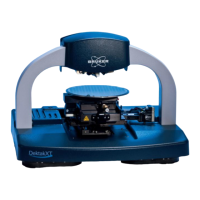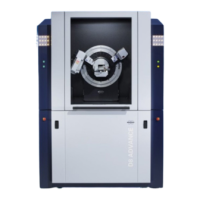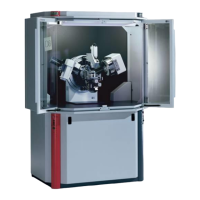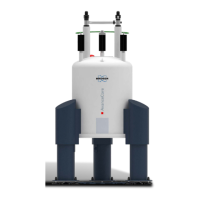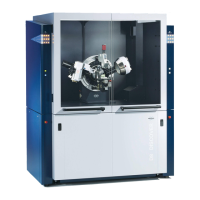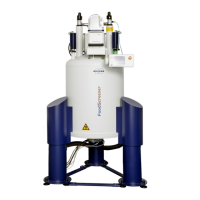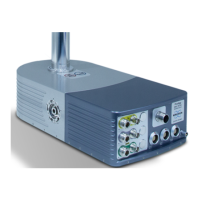User Manual D2 PHASER
DOC-M88-EXX141 V5 – 01.2015 16
b. Important detector settings are ‘resolution’ (angle in degree per stripe) and ‘zero offset’ (angle from
1
st
to reference stripe). These parameters were determined at Bruker AXS and may not be
changed.
c. The rotation sample holder and sample changer are factory aligned. The surface is parallel to
connection of the two rotation axes on the horizontal sliders and can only be realigned by Bruker
AXS personnel with a special tool set.
Caution!
Do not change these alignments (1a/b/c and 2a/b/c) by yourself because this causes
other misalignments which lead to false measurement results.
In the goniometer box there is an illumination LED lamp (fig. 40) in order to do proper work with
opened door or to see internal components like the sample or slit optics. The procedure described in
this manual ensures that all work can be done under full X-ray protection conditions.
Functional principle of the goniometer
Zero definition of the scale
Although the D2 is aligned perfectly, which means that the line peaks of the corundum standard
sample fit very well, it is possible that the zero of the scale does not coincide perfectly with the
primary beam direction. Sometimes there can be a difference of some hundredths of a degree.
We can only guarantee a good 2 calibration between 25°and 145°, which means that the verification
booklet reflections are OK and within the tolerance of ±0.02° in 2.
In this section the difference between the offset of the scale zero and the primary beam direction is
determined (so-called reference determination). Then the scale is shifted so that its zero point
coincides with the primary beam direction, i.e. sample surface and beam are parallel at zero position.
When the glass slit peak is shifted to 0.000° by a , also all other sample line peaks are shifted with
this offset . It is possible that the sample line peaks in the 2 region between 25° and 145° are
outside the 0.02° tolerance after this procedure. Please consider whether this is acceptable.
D2 PHASER user alignment with 1D-detector (LYNXEYE) and standard sample holder or
sample changer
The primary Soller and slit holder system is preset and aligned at Bruker AXS factory and fixed with a
sealed screw (X-ray radiation safety!). The beam will pass a 0.1mm slit and the glass slit
simultaneously at zero position (fig. 46). The user must follow the steps of the alignment procedure
described in the following:
1. Remove the beamstop absorber (fig. 134 & (x) in fig. 139).
2. Set the detector to 0D-mode ((a) of fig. 47) and the window width ((b) of fig. 47) to 5mm as seen in
the screenshot. Press ‘apply’ and then ‘ok’.
3. Disable sample rotation. Check whether the direct beam groove in the sample holder ring (fig.51 &
fig. 148) is in beam direction. Insert the glass slit module (fig. 48, fig. 49, fig. 50, fig. 52) manually
for rotation sample holder. In case of sample changer insert the small glass slit module (fig. 147)
to position n (fig. 139) tangentially to the magazine wheel and load sample position n by software.
Check again whether the direct beam groove in the sample holder ring (fig. 51, fig. 148) is in beam
direction and that the glas slit module has the same orientation (fig. 53 anf for sample changer fig.
149). Insert an absorber (Cu for Cu-radiation) into the holder position of the LYNXEYE (fig. 34).
4. Set the range of 2 from -1.0° to 1.0° (if the beam is not in this range then try a larger range), step
width to 0.01° and scan time to 0.1s with ‘locked coupled’ as scan type and ‘continuous psd fast
scan’ as scan mode (fig. 54, fig. 55). The screenshot shows an example of a scan where the glas
slit peak is shifted with respect to the zero of the 2 scale (fig. 55).
5. Move to ‘Reference And Offset Determination’ and go to ‘Reference’. This window shows the
determined peak position relative to the current scale. Read the Value ‘Current Reference’ and
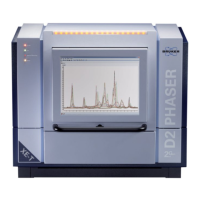
